By Aarav Sapra
A large and devastating cyclone caused widespread destruction across many Eastern Coast States—due in part to heavy rains, and severe flooding. As the hurricane tore through the gulf coast of Florida along with barraging Western North Carolina, Helene has been considered one of the deadliest storms to strike the U.S. mainland in nearly two decades–killing 200 people in a matter of days. This Category Four Hurricane pressed through the East Coast as it washed out roads, reshaped the topography of the Blue Ridge mountains, and knocked out power and cell service for millions of people.
The chaos in Carolina was part of the trail of destruction that Helene continued to carve along the East Coast, including portions of states such as Tennessee, South Carolina, and Virginia. Flash floods and dangerous landslides cut off communication in North Carolina as many roads were washed out with landslides, including most debris, trees, and mud. This complicated the officials’ measures to help the community, as residents were now isolated in their towns with no one available to rescue or aid. However, as crews try to overcome this monumental challenge of trying to clear these flooded roads, many federal search and rescue teams from other states have proceeded to help by airlifting food and other supplies to these communities, along with sending workers to restore their water systems.
After ripping through Florida, Hurricane Helene set multiple records. The Category Four Hurricane packed 140-mile-an-hour winds and broke storm surge records all along Florida’s Gulf Coast, including many that Hurricane Idalia set just over a year ago. Helene struck towns beyond Florida and North Carolina, resulting in unexpected weather in cities like Cincinnati. Muddy water and tornadoes knocked out power, and muddy waters and other debris overpowered some dams. In Tennessee, officials have confirmed at least 13 storm-related deaths, with more than 20 people missing from flood-affected areas.
Unfortunately, the death toll continues to rise. At least 228 people have been confirmed dead in six states—Florida, Georgia, North Carolina, South Carolina, Tennessee, and Virginia. The causes of death have been related to aftermath storm effects such as falling trees, floodwaters, and tornadoes. Tragically, the state with the highest number of fatalities is North Carolina, with at least 116 people pronounced dead by local officials. Among the death tolls are members of rescue teams who provided supplies and safety–such as the sheriffs in Madison County–have also tragically passed away in the floodwaters. As Helene continues to ruin the lives of many with its carved path of destruction, hopefully, efforts can be made to relieve the residents and transport them to safety.

